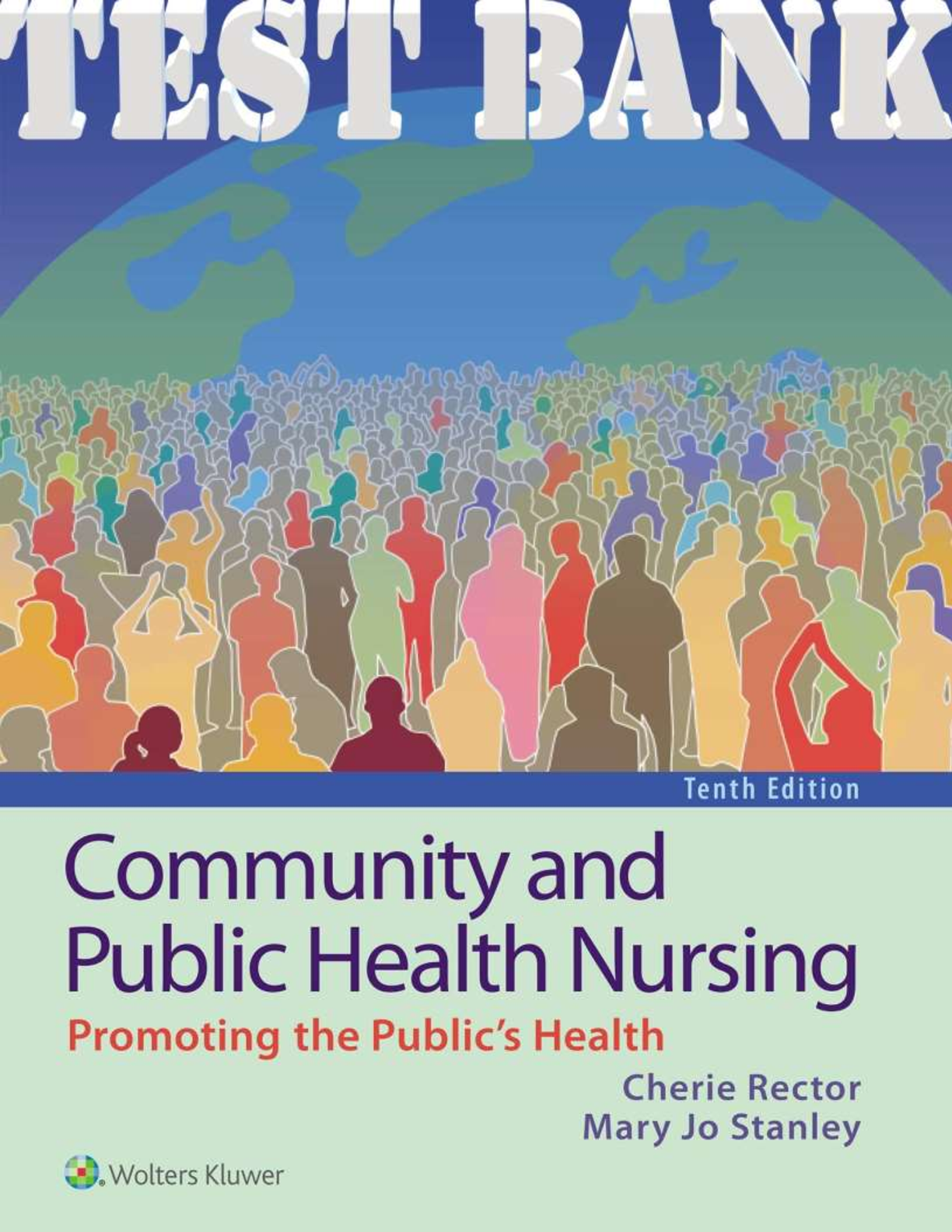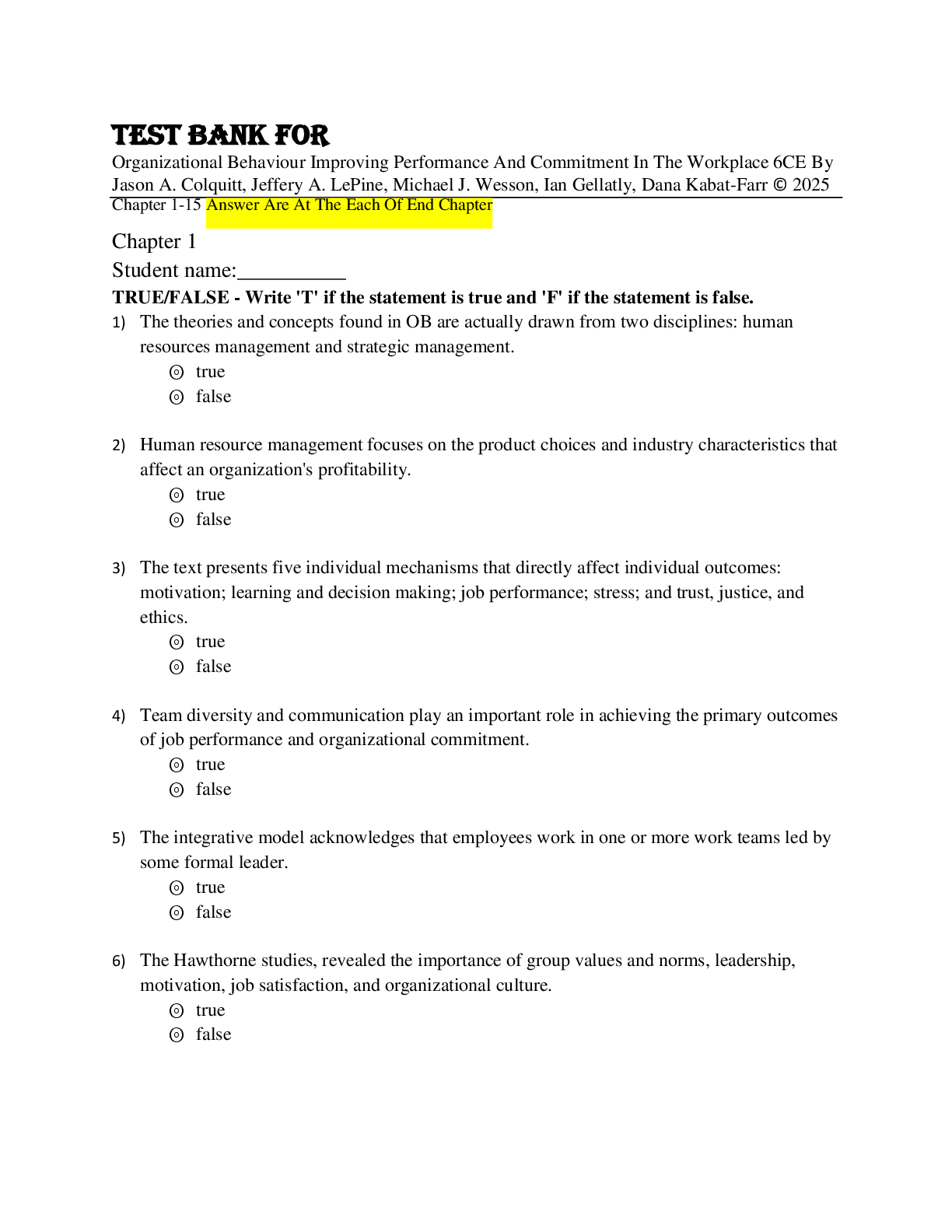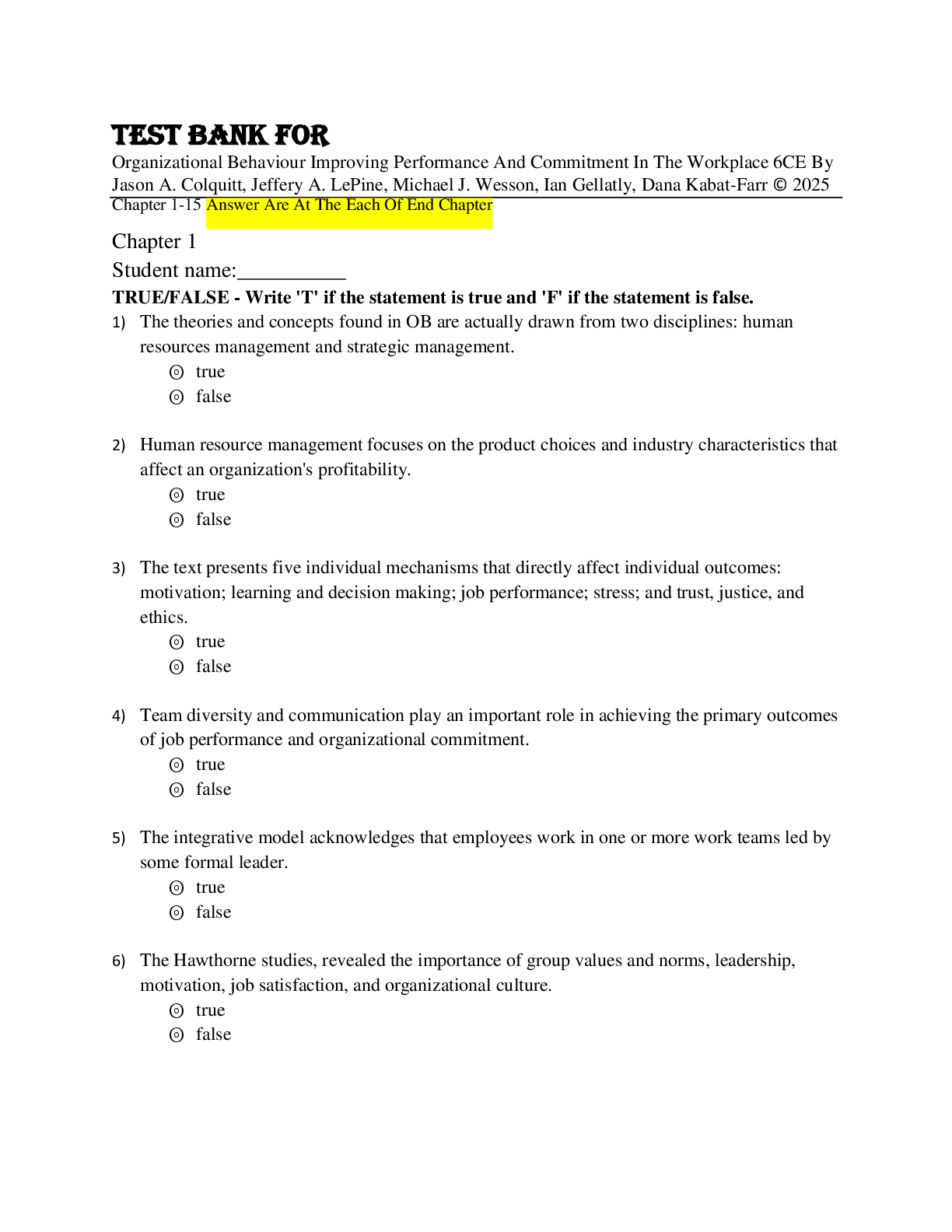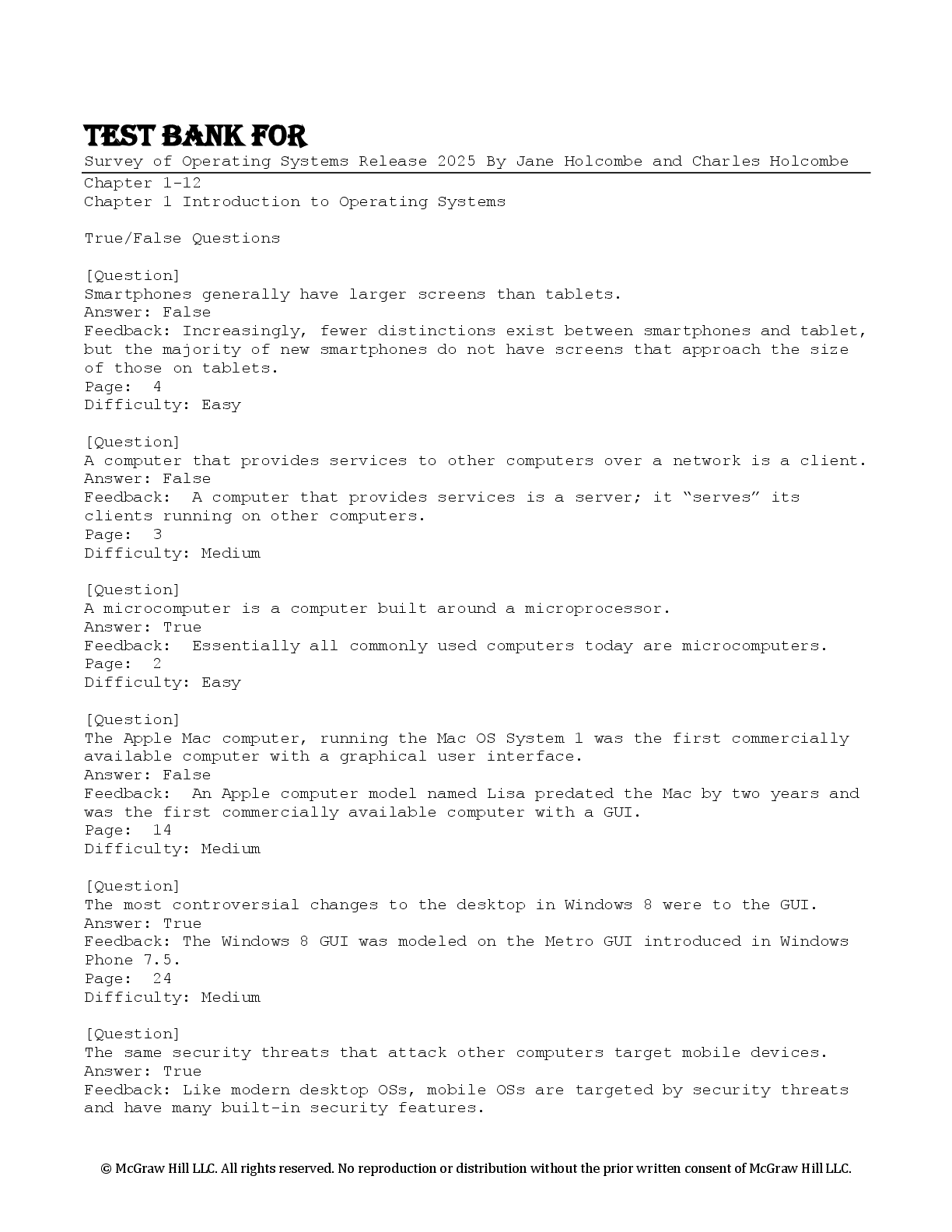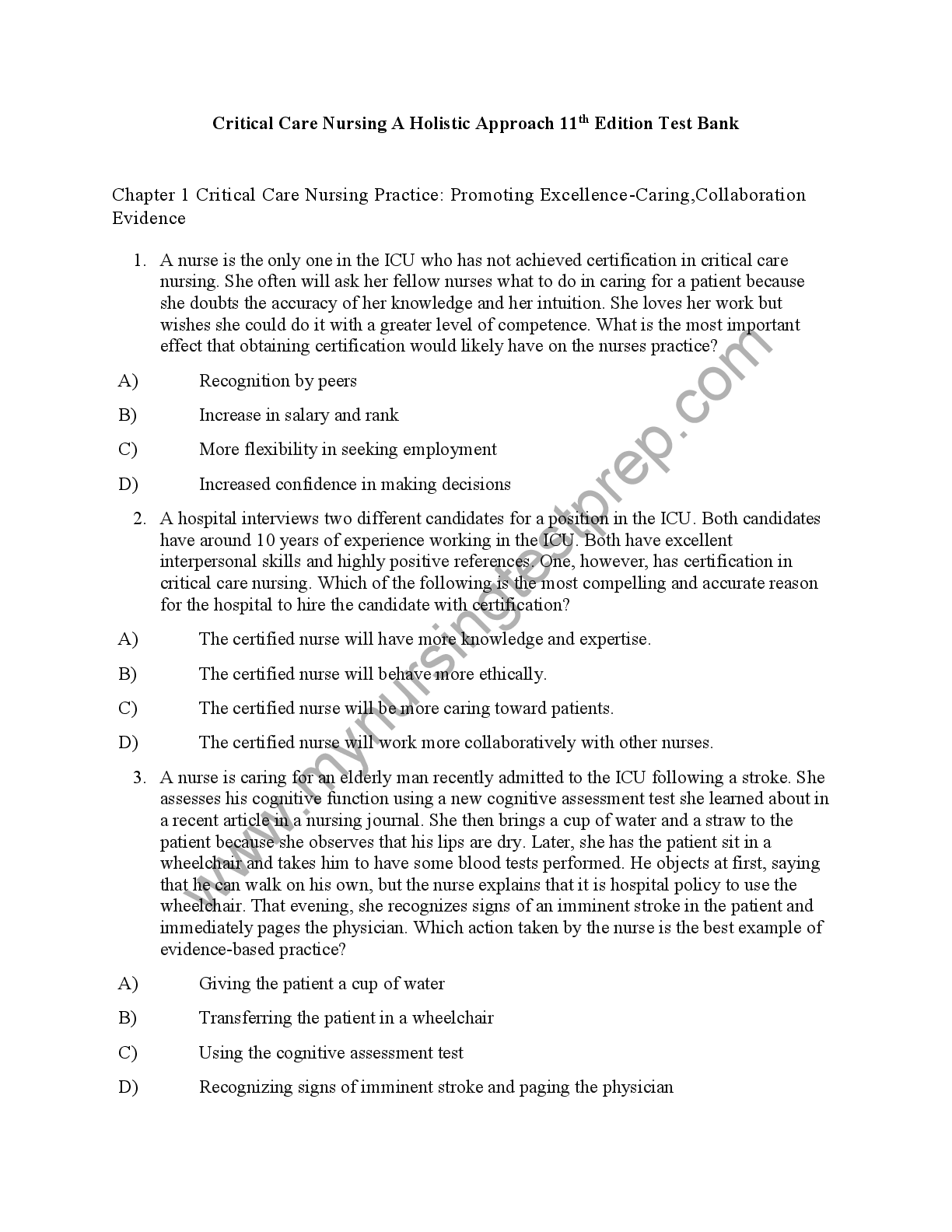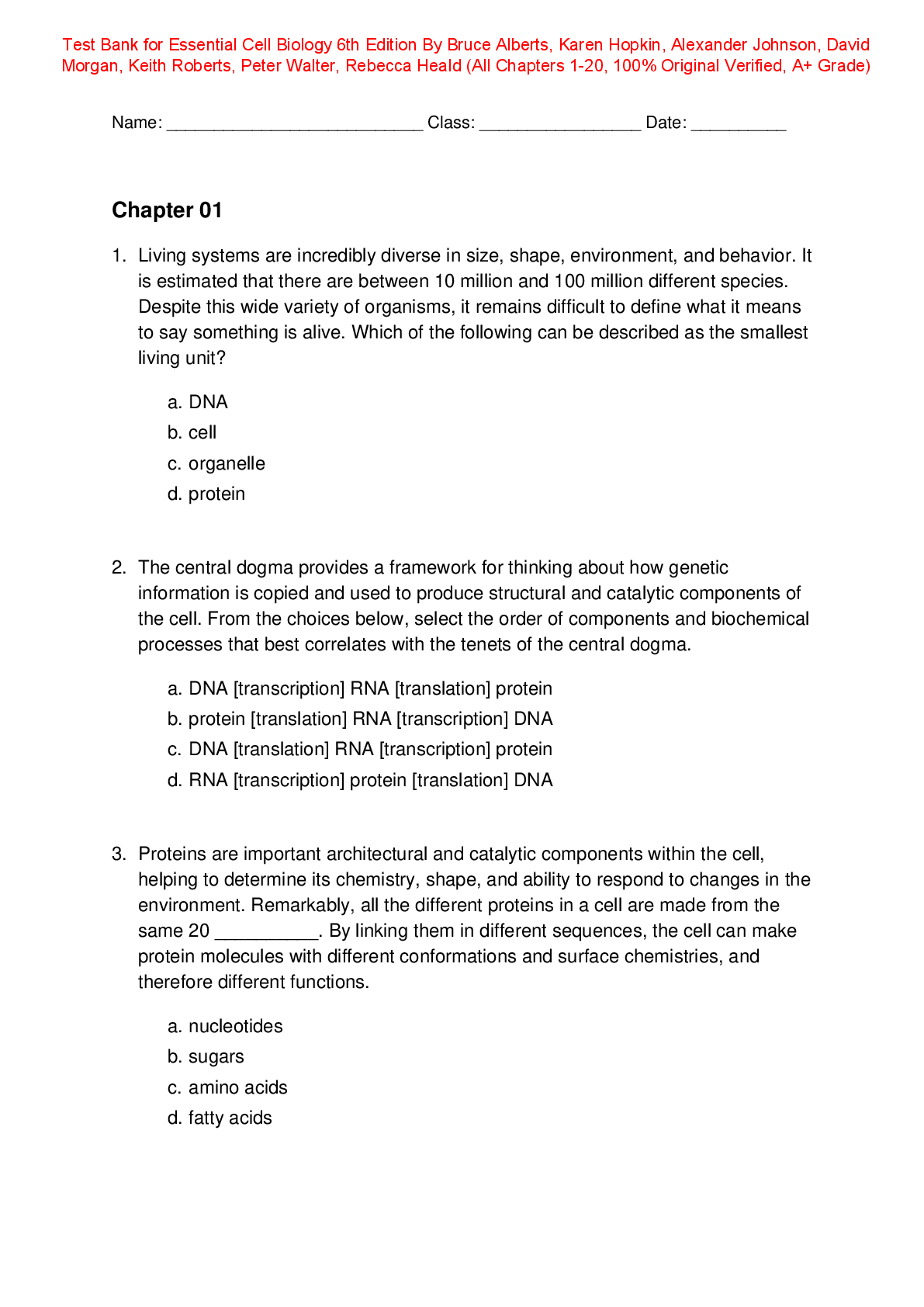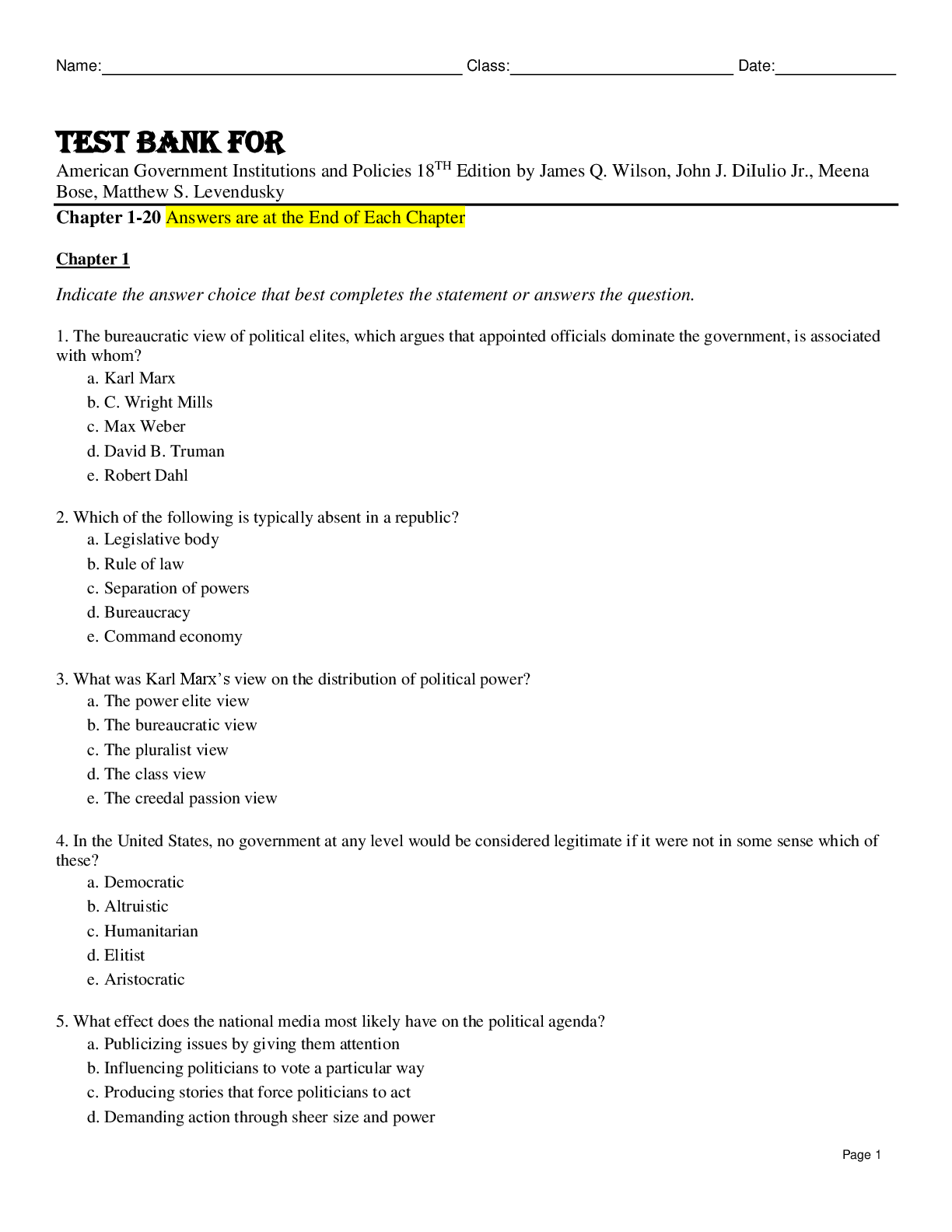Project Management > TEST BANKS > Chapter 08 Scheduling Resources and Costs Answer Key. 91 Questions and Answers (All)
Chapter 08 Scheduling Resources and Costs Answer Key. 91 Questions and Answers
Document Content and Description Below
Chapter 08 Scheduling Resources and Costs Answer Key Multiple Choice Questions 1. Resources are adequate, but demand varies widely over the life of the project. Delaying noncritical activities ... to lower peak demand on resources is known as resource A. Shifting B. Effectiveness C. Manipulating D. Smoothing E. Allocation 2. If resources are not adequate to meet peak demands, the resulting reschedule is termed A. Resource-constrained scheduling B. Time-constrained scheduling C. Mandatory leveling D. Project resource adjustment E. Allocation 3. Which of the following is NOT a potential consequence of failing to identify limited resources before project implementation? A. Activity delays B. Project delays C. Difficulty in taking quick corrective action D. Increase costs E. Scope creep 4. When developing a new software package, logically, the software must be designed before the code is written, and the code must be written before it is tested. These activities are dependent on each other by _________ constraints. A. Physical B. Technical C. Resource D. Schedule E. Time 5. When considering the sequence and timing of activities, which of the following is NOT one of the types of project network constraints? A. Physical B. Technical C. Resource D. Time E. All of these are types of constraints that could impact structure of the project network 6. Sam, the project engineer, has been scheduled to run the product system test at the same time he is to build a marketing prototype. This is an example of what type of resource constraint? A. Physical B. Technical C. People D. Equipment E. Time 7. Susan is to conduct environmental testing but the chamber cannot hold all the equipment that she wants to test. This is an example of a constraint that could impact the sequence and timing of activities in a project network. What type of constraint is it? A. Physical B. Technical C. Resource D. Scheduling E. Time 8. All of the following are types of resource constraints EXCEPT A. Materials B. People C. Equipment D. Information E. Human 9. Gene is trying to order the concrete needed to continue his project. However, the supplier will not be able to deliver it until next week. This is an example of what kind of resource constraint? A. Working capital B. People C. Equipment D. Information E. Materials 10. A special truck that George needs on his project has been scheduled on another project. This is an example of what type of resource constraint? A. Working capital B. People C. Equipment D. Information E. Materials 11. Most of the scheduling methods available today require the project manager to classify the project as either _______ constrained or ______ constrained. A. Time, quality B. Quality, resource C. Cost, time D. Quality, cost E. Time, resource 12. Regina's boss has told her that her project is very important. If the critical path is delayed, she will be given whatever she needs to get it back on schedule. Her project is classified as ________ constrained. A. Time B. Quality C. Cost D. Performance E. Resource 13. In reviewing the status of her project with top management, Shirley was told that there are only two programmers that she can use for her project. Her project is classified as __________ constrained. A. Time B. Quality C. Cost D. Performance E. Resource 14. All resource leveling techniques involve A. Delaying noncritical activities B. Delaying critical activities C. Using negative slack D. Delaying the project E. Adding resources 15. Technical constraints have been carefully considered when developing a project network. Which of the following is true at this point? A. Resources have been assigned to each activity so they are adequate to complete the project on time B. Activity 4 cannot be completed before activity 1 C. The project completion date can be established D. The project is ready to be implemented E. All of these are true statements once technical constraints have been established 16. Rachel is working on a project that technically allows three activities to be done at the same time. If they were to be implemented at the same time, she would need 5 contractors in order for the activities to be completed on time. There are only 3 available for her to use. This is an example of what type of constraint? A. Technical B. People C. Equipment D. Physical E. Materials 17. Resource leveling or smoothing can have all the following results on a project EXCEPT A. Lower peak resource demand B. Reduced resource need over the life of the project C. Reduced fluctuations in resource demand D. A longer project duration E. A more sensitive network 18. Jan is trying to reallocate resources in a time-constrained project to create smoother resource utilization. She should first identify activities with the A. Smallest duration B. Least slack C. Most slack D. Lowest identification number E. Highest cost 19. In a resource-constrained project, which of the following is most likely to be changed? A. The completion date B. The budget C. Project quality D. Resource levels E. Scope creep 20. In a resource-constrained project, the first priority in assigning resources is usually given to activities with the A. Smallest duration B. Least slack C. Most slack D. Lowest identification number E. Highest cost 21. In a resource-constrained project the second priority in assigning resources is usually given to activities with the A. Smallest duration B. Least slack C. Most slack D. Lowest identification number E. Highest cost 22. Tony has realized that two activities in his project cannot be done at the same time because not enough resources are available. Activity 3 is critical and has a duration of 5 days. Activity 4 has 2 days of slack and a duration of 2 days. How will he decide which activity should be scheduled first? A. The activity with the smallest duration B. The activity with the least slack C. The activity with the most slack D. The activity with the lowest identification number E. The activity with the highest cost 23. Splitting an activity can result in all of the following EXCEPT A. More people working on the same activity B. Possible startup and shutdown costs C. A resource may be moved from one activity to another and then back D. Activity work being placed on hold for a period until more resources are available E. A better project schedule 24. All of the following are benefits of scheduling resources before project implementation EXCEPT A. Allows time for considering reasonable options if resource constraints do exist B. The project completion date can be established C. Work packages can be time-phased D. Allows managers to share resources with other project managers if it is requested without negatively impacting their project. E. Ensures low network sensitivity 25. These are all guidelines a project manager should consider when assigning project work EXCEPT A. Select people with compatible work habits and personalities B. Always assign the best people to the most difficult tasks C. When possible, team veterans up with new hires D. Select individuals with skillsets that complement each other E. Have people work together early so that they can become familiar with each other 26. When a company will reduce the number of projects they have to manage internally to only core projects and send noncritical projects to contractors and consulting firms this is called A. Outsourcing B. Redistribution of projects C. Project allocation D. Task sharing E. Referring 27. Which of the following is NOT one of the more common problems associated with scheduling multiproject resources? A. Overall schedule slippage B. Inefficient resource utilization C. Decline in project quality D. Resource bottlenecks E. Delays in one project cause delays in other projects 28. In a resource-constrained project the third priority in assigning resources is usually given to activities with the A. Smallest duration B. Least slack C. Most slack D. Lowest identification number E. Highest cost 29. Why is it necessary to have a time-phased budget baseline? A. For proper resource allocation B. So we know how much work was accomplished for the money spent C. To reduce schedule slippage when scheduling multiproject resources D. It is not necessary to have a time-phased budget baseline E. To reduce fluctuations in cash flow during the project 30. Project budgets are developed by time-phasing which of the following? A. Resource schedules B. Work packages C. The network diagram D. Critical activities E. None of these are time-phased to develop a project budget 31. A project budget report is showing our project as spending $35,000 against a budgeted amount of $40,000. Which of the following is true? A. We are spending less than we should for the project B. We are doing a good job managing the project C. We should check to see if all the bills have been paid D. We have more money to put into budget reserves E. We can't be sure how the project is going Fill in the Blank Questions 32. Delaying noncritical activities to lower peak demand and, thus, increase resource utilization is called resource __________. leveling or smoothing 33. A(n) ________ constraint addresses the sequence in which project activities must occur even after considering resource constraints. 34. Having one person responsible for performing several activities, all due at the same time, is an example of a(n) ________ constraint. : If one person must perform all activities, the resource constraint requires the 35. Trying to renovate a ship compartment that is too small for more than one person is an example of a(n) ________ resource constraint. : Types of Resource Constraints Level: Easy 36. A shortage of programmers to write software is an example of a(n) ________ type of resource constraint. 37. The shortage of computer chips to produce a circuit board is an example of a(n) ________ type of resource constraint. materials Feedback: Material availability and shortages have been blamed for the delay of many projects. When it is known that a lack of availability of materials is important and probable, materials should be included in the project network plan and schedule. AACSB: Reflective Thinking Bloom's: Understand Learning Objective: Types of Resource Constraints Level: Easy 38. If three copiers are needed to produce a final report on time and only two are available, the project is facing a(n) ________ type of resource constraint. 39. Resource dependency takes priority over the technological dependency but does not violate ___________ dependencies. Feedback: Resource dependency takes priority over the technological dependency but does not violate technical dependencies; that is, hiring a band, decorating the hall, and purchasing refreshments may have to be done in sequence rather than at the same time, but they all must be complete before the reception. AACSB: Reflective Thinking Bloom's: Understand Learning Objective: Overview of the Resource Scheduling Problem Level: Medium 40. In order that the new product is on the shelf for the Christmas buying season, the development of the new product would be classified as a(n) ________ -constrained project. Feedback: A time-constrained project is one that must be completed by an imposed date. If required, resources can be added to ensure the project is completed by a specific date. Although time is the critical factor, resource usage should be no more than is necessary and sufficient. AACSB: Reflective Thinking Bloom's: Understand Learning Objective: Classification of a Scheduling Problem Level: Medium 41. Beth has two engineers assigned to her project and does not have access to more even if the result means extending the completion date on her project. She is managing a(n) ________ -constrained project. Feedback: A resource-constrained project is one that assumes the level of resources available cannot be exceeded. If the resources are inadequate, it will be acceptable to delay the project, but as little as possible. AACSB: Reflective Thinking Bloom's: Understand Learning Objective: Classification of a Scheduling Problem Level: Medium 42. All leveling techniques delay noncritical activities by using ________ to reduce peak demand. Feedback: All leveling techniques delay noncritical activities by using positive slack to reduce peak demand and fill in the valleys for the resources. AACSB: Reflective Thinking Bloom's: Understand Learning Objective: Resource Allocation Methods Level: Medium 43. When scheduling activities in a resource-constrained project, typically the activity scheduled first has the __________ amount of slack. Feedback: In resource-constrained scheduling activities that were once scheduled to be completed at the same time now may have to be scheduled in sequence. The activity with the least amount of slack will be scheduled first. If the activities have the same amount of slack the activity with the shortest duration will be scheduled first. If the activities have the same duration the activity with the lowest activity identification number will be scheduled first. AACSB: Reflective Thinking Bloom's: Understand Learning Objective: Resource Allocation Methods Level: Easy 44. Since resource leveling or smoothing delays noncritical activities, a common result is an increase in network ___________. Feedback: As noncritical activities are delayed, slack levels are reduced which increases the number of critical and noncritical activities. This results in an increase in network sensitivity. AACSB: Reflective Thinking Bloom's: Understand Learning Objective: Resource Allocation Methods Level: Medium 45. When the work in an activity is interrupted to work on another activity and is then resumed at a later point in time, it is called _________. Feedback: A planner splits the continuous work included in an activity by interrupting the work and sending the resource to another activity for a period of time and then having the resource resume work on the original activity. AACSB: Reflective Thinking Bloom's: Understand Learning Objective: Splitting Activities Level: Medium 46. In scheduling resource-constrained projects, _________ are typically used rather than optimum mathematical solutions. Feedback: A few researchers have demonstrated optimum mathematical solutions to the resource allocation problem but only for small networks and very few resource types. The massive data requirements for larger problems make pure mathematical solutions (e.g., linear programming) impractical. An alternative approach to the problem has been the use of heuristics (rules of thumb) to solve large combinatorial problems. AACSB: Reflective Thinking Bloom's: Remember Learning Objective: Resource Allocation Methods Level: Medium 47. When classifying projects, ________ constrained means that project duration is fixed and resources are flexible. Feedback: In scheduling terms, time constrained means time (project duration) is fixed and resources are flexible. AACSB: Reflective Thinking Bloom's: Understand Learning Objective: Classification of a Scheduling Problem Level: Easy 48. When classifying projects, ________ constrained means that a specific resource is fixed and the duration of the project is flexible. Feedback: In scheduling terms, resource constrained means resources are fixed and time is flexible. AACSB: Reflective Thinking Bloom's: Understand Learning Objective: Classification of a Scheduling Problem Level: Easy 49. Startup and shutdown costs are major considerations when using the ________________ scheduling technique. Feedback: The most common error is to interrupt "people work," where there are high conceptual startup and shutdown costs. AACSB: Reflective Thinking Bloom's: Understand Learning Objective: Splitting Activities Level: Easy 50. After resource leveling or smoothing one goal is that the amount of resources needed over the life of the project will be ___________. Feedback: The three goals of smoothing are to reduce the peak demand for resources, to reduce the resources needed over the life of the project and to reduce the fluctuations in resource demand. AACSB: Reflective Thinking Bloom's: Understand Learning Objective: Resource Allocation Methods Level: Easy 51. Many companies are ________ project work to contractors and consultants as a means of dealing with the peaks and valleys of resource allocation among projects. Feedback: Many companies are using outsourcing as a means for dealing with their resource allocation problems. In some cases, a company will reduce the number of projects they have to manage internally to only core projects and outsource noncritical projects to contractors and consulting firms. In other cases, specific segments of projects are outsourced to overcome resource deficiencies and scheduling problems. AACSB: Reflective Thinking Bloom's: Understand Learning Objective: Multiproject Resource Schedules Level: Easy 52. When a project is classified as resource-constrained and a resource constraint exists, the project duration is typically __________. Feedback: If resources are not adequate to meet peak demands and there is no access to further resources, activities might take longer than initially planned. Furthermore, activities that technically could be done at the same time will have to be done one after the other if the same resources are required for each. This will delay the completion date. AACSB: Reflective Thinking Bloom's: Understand Learning Objective: Resource Allocation Methods Level: Easy 53. In reality resource allocation generally occurs in a(n) ___________ environment where the demands of one project have to be reconciled with the needs of other projects. Feedback: In reality resource allocation generally occurs in a multiproject environment where the demands of one project have to be reconciled with the needs of other projects. Organizations must develop and manage systems for efficiently allocating and scheduling resources across several projects with different priorities, resource requirements, sets of activities, and risks. AACSB: Reflective Thinking Bloom's: Understand Learning Objective: Multiproject Resource Schedules Level: Medium 54. Without a __________ budget a good project schedule and cost control are impossible. Feedback: These systems do not measure how much work was accomplished for the money spent! Hence, without time-phasing cost to match your project schedule, it is impossible to have reliable information for control purposes. AACSB: Reflective Thinking Bloom's: Understand Learning Objective: Using the Resource Schedule to Develop a Project Cost Baseline Level: Medium 55. A project cost baseline is also called __________. Feedback: The outcome of these budget allocations is the project cost baseline (also called planned value—PV), which is used to determine cost and schedule variances as the project is implemented. AACSB: Reflective Thinking Bloom's: Remember Learning Objective: Using the Resource Schedule to Develop a Project Cost Baseline Level: Medium True / False Questions 56. The fact that you must pour foundation before you frame the house and that you have to frame the house before you can put on the roof demonstrates scheduling constraints. Feedback: The start and sequence of activities have been based solely on technical or logical considerations. For example, a project network for framing a house might show three activities in a sequence: (1) pour foundation, (2) build frame, and (3) cover roof. AACSB: Reflective Thinking Bloom's: Understand Learning Objective: Overview of the Resource Scheduling Problem Level: Easy 57. Too many parallel activities for one individual is an example of a resource constraint. Feedback: If one person must perform all activities, the resource constraint requires the activities be performed in sequence or series. AACSB: Reflective Thinking Bloom's: Understand Learning Objective: Overview of the Resource Scheduling Problem Level: Medium 58. The level of resources each activity will need to be completed in the given amount of time has been estimated; therefore, there are no resource constraints. Feedback: The time estimates for the work packages and network times were made independently with the implicit assumption that resources would be available. This may or may not be the case. AACSB: Reflective Thinking Bloom's: Understand Learning Objective: Overview of the Scheduling Problem Level: Medium 59. Resource leveling or smoothing is only used on projects which are resource constrained. Feedback: Practitioners have attacked the utilization problem using resource leveling techniques that balance or smooth demand for a resource. Basically, all leveling techniques delay noncritical activities by using positive slack to reduce peak demand and fill in the valleys for the resources. Resource leveling or smoothing can be used for both resource-constrained and time-constrained projects. AACSB: Reflective Thinking Bloom's: Understand Learning Objective: Resource Allocation Methods Level: Medium 60. Resource bottlenecks are one of the three more common problems encountered in managing multiproject resource schedules. Feedback: Overall schedule slippage (delays in one project cause delays in other projects), inefficient resource utilization, and resource bottlenecks are all common problems associated with scheduling multiproject resources. AACSB: Reflective Thinking Bloom's: Remember Learning Objective: Multiproject Resource Schedules Level: Medium 61. The inability to fit more than two earth movers on a construction site at the same time when more are needed to complete the activity on time is an example of a physical constraint. Feedback: In rare situations, physical factors cause activities that would normally occur in parallel to be constrained by contractual or environmental conditions. AACSB: Reflective Thinking Bloom's: Understand Learning Objective: Types of Resource Constraints Level: Medium 62. In a resource-constrained project, the completion date is most likely to change. Feedback: If resources are not adequate to meet peak demands and there is no access to further resources, activities might take longer than initially planned. Furthermore, activities that technically could be done at the same time will have to be done one after the other if the same resources are required for each. This will delay the completion date. AACSB: Reflective Thinking Bloom's: Understand Learning Objective: Resource Allocation Methods Level: Easy 63. Having too few programmers and too many engineers is an example of a people resource constraint. Feedback: Finding people with certain differing skills adds to the complexity of scheduling projects. Human or people resource constraints are the most common resource constraint. AACSB: Reflective Thinking Bloom's: Understand Learning Objective: Types of Resource Constraints Level: Medium 64. If a project needs one earth mover six months from now in order to complete one activity, and the organization has four such machines, there is no equipment resource constraint. Feedback: The most common oversight is to assume the resource pool is more than adequate for the project. For example, if a project needs one earth-moving tractor six months from now and the organization owns four, it is common to assume the resource will not delay the pending project. However, when the earth-moving tractor is due on-site in six months, all four machines in the pool might be occupied on other projects. AACSB: Reflective Thinking Bloom's: Understand Learning Objective: Types of Resource Constraints Level: Medium 65. A lack of readily available engineers is a technical constraint. Feedback: When the number of people and/or equipment is not adequate to meet peak demand requirements and it is impossible to obtain more, the project manager faces a resource-constrained problem. AACSB: Reflective Thinking Bloom's: Understand Learning Objective: Types of Resource Constraints Level: Easy 66. Resource dependency takes priority over technological dependency but it does not violate it. Feedback: Resource dependency takes priority over the technological dependency but does not violate a technical dependency; that is, hiring a band, decorating the hall, and purchasing refreshments may have to be done in sequence rather than at the same time, but they all must be complete before the reception. AACSB: Reflective Thinking Bloom's: Understand Learning Objective: Overview of the Resource Scheduling Problem Level: Medium 67. To determine if a project is time-constrained or resource-constrained you would consult the project priority matrix. Feedback: Project managers need to consult their priority matrix to determine which case fits their project. AACSB: Reflective Thinking Bloom's: Understand Learning Objective: Classification of a Scheduling Problem Level: Medium 68. Sequential activities hold just as much potential for resource conflicts as parallel activities. Feedback: A network planner may assume adequate resources and show activities occurring in parallel. However, parallel activities hold potential for resource conflicts. AACSB: Reflective Thinking Bloom's: Understand Learning Objective: Overview of the Resource Scheduling Problem Level: Medium 69. All leveling techniques delay noncritical activities by using positive slack to smooth out the resource requirements. Feedback: All leveling techniques delay noncritical activities by using positive slack to reduce peak demand and fill in the valleys for the resources. AACSB: Reflective Thinking Bloom's: Understand Learning Objective: Resource Allocation Methods Level: Medium 70. Since resource leveling or smoothing delays noncritical activities, a common result is a decrease in network sensitivity. Feedback: As noncritical activities are delayed, slack levels are reduced which increases the number of critical and noncritical activities. This results in an increase in network sensitivity. AACSB: Reflective Thinking Bloom's: Understand Learning Objective: Resource Allocation Methods Level: Medium 71. Scheduling projects classified as resource-constrained focuses on completing the project as soon as possible under the given resource constraints. Feedback: When the number of people and/or equipment is not adequate to meet peak demand requirements and it is impossible to obtain more, the project manager faces a resource-constrained problem. Something has to give. The trick is to prioritize and allocate resources to minimize project delay without exceeding the resource limit or altering the technical network relationships. AACSB: Reflective Thinking Bloom's: Understand Learning Objective: Resource Allocation Methods Level: Difficult 72. When resource constraints are added to technical constraints the original project network may change as well as the completion date. Feedback: When resource constraints are added to technical constraints the original project network may change as well as the completion date. The traditional critical path concept of sequential activities from the start to end of the project is no longer meaningful. AACSB: Reflective Thinking Bloom's: Understand Learning Objective: Resource Allocation Methods Level: Medium 73. When scheduling activities in a resource-constrained project typically the activity scheduled first has the most amount of slack. Feedback: In resource-constrained scheduling, activities that were once scheduled to be completed at the same time now may have to be scheduled in sequence. The activity with the least amount of slack will be scheduled first. If the activities have the same amount of slack the activity with the shortest duration will be scheduled first. If the activities have the same duration the activity with the lowest activity identification number will be scheduled first. AACSB: Reflective Thinking Bloom's: Understand Learning Objective: Resource Allocation Methods Level: Medium 74. A project budget report is showing our project as spending $35,000 against a budgeted amount of $40,000. We can assume that everything is going as planned and that we are under budget. Feedback: There is no way to be certain how much of the physical work has been accomplished for the money we have spent. AACSB: Reflective Thinking Bloom's: Understand Learning Objective: Using the Resource Schedule to Develop a Project Cost Baseline Level: Difficult 75. Splitting is a scheduling technique used to get a better schedule or better resource utilization and should be used without hesitation. Feedback: Splitting tasks is a scheduling technique used to get a better project schedule and/or to increase resource utilization. However, planners should avoid the use of splitting as much as possible, except in situations where splitting costs are known to be small or when there is no alternative for resolving the resource problem. AACSB: Reflective Thinking Bloom's: Understand Learning Objective: Splitting Activities Level: Easy 76. Without a time-phased budget a good project schedule and cost control are impossible. Feedback: Without a time-phased budget a good project schedule and cost control are impossible and we are not able to measure how much work was accomplished for the money spent. AACSB: Reflective Knowledge Bloom's: Understand Learning Objective: Using the Resource Schedule to Develop a Project Cost Baseline Level: Easy 77. If resources are truly limited and activity time estimates are accurate, the resource-constrained schedule will materialize as the project is implemented, not the time-constrained schedule. Feedback: If resources are truly limited and activity time estimates are accurate, the resource-constrained schedule will materialize as the project is implemented, not the time-constrained schedule. In other words if there are not enough resources to complete an activity, you should know now because the problem will not solve itself. Failure to schedule limited resources can lead to serious problems for the project managers. AACSB: Reflective Thinking Bloom's: Understand Learning Objective: Benefits of Scheduling Resources Level: Medium 78. Project managers should always assign the best people to the most difficult tasks. tasks. Project managers need to be careful not to overdo this. Over time these people may grow to resent the fact that they are always given the toughest assignments. At the same time, less experienced participants may resent the fact that they are never given the opportunity to expand their skill/knowledge base. AACSB: Reflective Thinking Bloom's: Understand Learning Objective: Assigning Project Work Level: Medium Short Answer Questions 79. Identify and briefly describe the three types of project constraints that could impact or change the structure of project network. Feedback: 1. Technical (logic); the sequence that activities must be performed. 2. resource; the absence of required people, materials, equipment, or working capital. 3. physical; limitations based on space or environmental limits. AACSB: Reflective Thinking Bloom's: Understand Learning Objective: Overview of the Resource Scheduling Problem and Types of Resource Constraints Level: Medium 80. What is the difference in project goals when using resource leveling on time-constrained projects and using it on resource-constrained projects? 81. Why is a schedule not a schedule until resources have been assigned? Provide a real life example that illustrates your explanation. 82. Identify and give an example of the three types of resource constraints. 83. Identify and briefly describe two ways to classify projects with scheduling problems. 84. List and briefly describe the disadvantages of resource leveling or smoothing. 86. After constructing a project network based on technical constraints and reviewing resource requirements throughout the project, Anne realizes many peaks and valleys in regard to resource usage. At one point Anne needs 6 developers, but top management has made it very clear that she will not have access to more than 4. Classify Anne’s project in terms of her scheduling problem. What are her options at this point? 87. When using resource-constrained scheduling, activities that were once scheduled to be completed at the same time now may have to be scheduled in sequence. What are the “rules of thumb” or heuristics that need to be followed to determine which activity is scheduled first? 88. Why should project managers be cautious about using the splitting scheduling technique? 89. Why is it important to make efforts to identify resource scheduling problems before the project is implemented? 90. Why is it critical to form a time-phased budget? 91. If your project has spent $50,000 versus a budget of $45,000 and it is a week ahead of schedule, is it a certainty that your project is doing well? Explain why or why not. [Show More]
Last updated: 2 years ago
Preview 1 out of 36 pages

Buy this document to get the full access instantly
Instant Download Access after purchase
Buy NowInstant download
We Accept:

Also available in bundle (1)
Click Below to Access Bundle(s)
.png)
PROJECT MANAGEMENT BUNDLE CONTAINS BUSI 3309: Chapter 01 Modern Project, Chapter 02 Organization Strategy and Project Selection, Chapter 04 Defining the Project, Chapter 05 Estimating Project Times and Costs, AND Chapter 08 Scheduling Resources and Costs. TEST BANKS WITH ANSWER KEY
PROJECT MANAGEMENT BUNDLE CONTAINS BUSI 3309: Chapter 01 Modern Project, Chapter 02 Organization Strategy and Project Selection, Chapter 04 Defining the Project, Chapter 05 Estimating Project Times a...
By QuizMaster 4 years ago
$32
5
Reviews( 0 )
$6.50
Can't find what you want? Try our AI powered Search
Document information
Connected school, study & course
About the document
Uploaded On
Jan 18, 2021
Number of pages
36
Written in
All
Additional information
This document has been written for:
Uploaded
Jan 18, 2021
Downloads
0
Views
194





